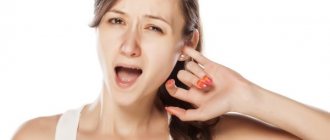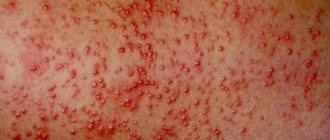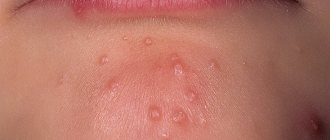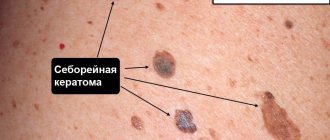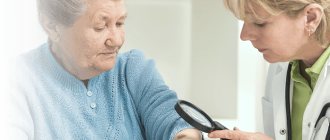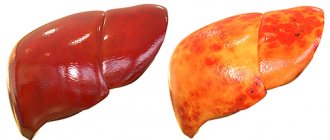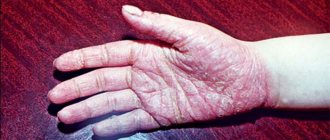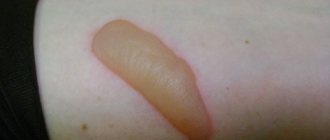09.09.2016 Sunburn is characterized by inflammation of the skin caused by excessive exposure to sunlight.
Common symptoms of sunburn:
- inflammation and redness of the skin at the burn site, pain when touching the affected area;
- After sun exposure for several days, the skin may swell, swell, turn red and blister;
- sometimes the total body temperature increases to 39-40C.
The severity of symptoms depends on a number of factors:
- skin type;
- medications taken;
- location and duration of sun exposure;
- degree of sun protection of the cream.
Sunburn and heatstroke do not appear immediately. Even when the skin suffers from strong exposure to sunlight, no visible changes are observed in the next couple of hours. This is a delayed action mechanism. Symptoms fully manifest themselves after 12–14 hours; only 4–7 days after a sunburn does the burnt layer of skin begin to peel off.
Important! There may be no telltale symptoms of a sunburn, but prolonged exposure to the sun will affect the skin, thereby increasing the risk of freckles, wrinkles, or skin cancer.
Causes
Burns occur due to the fact that the pigment melanin, which protects the skin from sunlight, ceases to perform its function during intense long-term exposure to ionizing radiation.
Risk factors:
- physiological features (blue eyes, blond hair and skin);
- outdoor work;
- rest in a sunny region with an unusual climate for humans;
- tanning without using sunscreen;
- spraying the skin with water when sunbathing, bathing;
- taking certain medications that make the skin more sensitive to solar radiation (tetracyclines, diabetes medications, oral contraceptives, diuretics, and a number of others).
Diagnostic measures
Before treating a 2nd degree burn, it is necessary to assess the extent and depth of tissue damage. You should definitely consult a doctor in the following situations:
- More than 5% of the skin surface is affected (in children - more than 2%).
- Localization - on the face or perineum, or the respiratory tract and esophagus are affected.
- The pain only gets worse over time.
- Swelling appears and foci of suppuration develop.
With a 2nd degree burn, bubbles with transparent contents usually appear. To determine the affected area, use the palm rule, the essence of which is that the area of the palm is counted as 1%. Based on this, they determine how much the affected area has spread and decide whether hospitalization is necessary. Even with a small degree of burn, but a significant area of damage, there is a risk of painful shock.
Degrees and symptoms
With a first degree burn, the following clinical picture is observed:
- skin redness;
- itching;
- slight swelling;
- mild pain;
- feeling of skin tightness.
If not only the top layer of skin is affected, but also the dermis, then this is a second-degree burn. In this case, the patient experiences the following symptoms:
- severe swelling and redness;
- the appearance of blisters on the skin;
- severe pain;
- chills;
- general malaise;
- increase in body temperature.
Folk remedies
“Grandma’s recipes” can also have an effect on sunburn. These are sour cream, milk, kefir, egg white. These products contain proteins that prevent moisture loss and restore skin.
Important! Traditional medicines will really be effective if used at least twice a day. But, no matter what method is chosen to eliminate sunburn, it is imperative to moisturize the skin afterwards.
In terms of choosing creams, preference should be given to those containing hyaluronic acid, cactus extracts, aloe, sea buckthorn, green tea, and rosemary. Medical aerosols against sunburn and after-sun preparations do a good job of doing this.
If your child gets a sunburn
If you find that your child has sunburn, you should prepare a cold bath for him. Bathing in a bath with oatmeal gives a good effect. To do this, you need to take regular oatmeal, pour it into a cloth bag, tie it with thread and put it in the bath or hang it under the shower. The child should stay in such a bath for 5–15 minutes, after which he should be gently blotted with a towel so that a small layer of oatmeal powder remains on the skin. This will help relieve itching and soften the skin.
It is necessary that the child receives a sufficient amount of fluid. On the day of the burn and the next three days, the child should drink a lot of water. For damaged skin of a child, the general remedies described above are suitable.
Another important point is the child’s nutrition. Vitamin C can strengthen the immune system and also have a slight anti-inflammatory effect. It is better to give preference to varieties with bioflavonoids. The dosage for a child depends on his age, multiplied by 50 milligrams. The medicine is given twice a day, but if diarrhea begins, the dose should be reduced.
It is advisable to use liquid or powdered (non-acidic) vitamin C. These solutions are suitable for children and infants and can be used by adding to juice. Zinc will help strengthen the immune system and speed up skin regeneration. The dose for children under 2 years old is 5 milligrams, over two years old - 10–15 milligrams. The drug is given for two weeks, after which the course ends.
The carotenoid complex is given prophylactically. Carotenoids often help absorb sunlight and protect the skin from damage. Given with a multivitamin complex.
Important! When your child's skin becomes blistered and the temperature cannot be brought down, you should immediately consult a doctor.
When treating sunburn, proper diet is important. It is advisable to include fresh fruits and vegetables in your diet, as they contain large amounts of vitamins E and C, and without them, skin healing and regeneration will slow down. If for some reason it is not possible to consume fresh fruits and vegetables, care should be taken to take synthesized vitamins. They are present on the shelves of almost all pharmacies. There you can select a pharmacological drug based on the active ingredient ibuprofen. Timely intake of ibuprofen will relieve the skin inflammatory reaction, normalize the temperature of the human body, and significantly reduce the intensity of pain.
First aid at home
To quickly soothe itchy skin of the feet and other parts of the body, it is important to start treatment on time. First medical aid for sunburn for an adult is to get out of the sun as quickly as possible, preferably go indoors. Once the sun's rays are no longer exposed to the skin, you should relieve pain and discomfort using the following recommendations:
- To reduce pain, it is recommended to regularly take a cool shower;
- after leaving the bath, you need to carefully and gently pat your body dry with a towel, then apply a moisturizer with aloe vera, oat milk, soy, this will help reduce pain and soothe the skin;
- for severe burns, ointments with 1% hydrocortisone can be applied to the inflamed areas of the skin;
- for severe pain, you can take NSAIDs orally;
- with the development of edema, it is recommended to take antihistamines internally, as well as apply antiallergic drugs externally to the lesions;
- You need to drink more fluids to help avoid dehydration.
First aid for a sunburn victim if blisters appear is to apply special bandages with reparatives or silicone to the affected areas. Under no circumstances should you try to pierce the blisters yourself, as damage to them increases the pain. In addition, pathogenic microflora can penetrate into the lesion, which will lead to the development of a secondary infection. Folk remedies can be used as an auxiliary therapy.
What to do if you have a sunburn
When you receive a burn, it is important to promptly carry out treatment measures to eliminate symptoms and prevent complications. If you take the correct actions and there are no serious damage to the skin, you will not need to see a doctor; within a week your health will be completely restored.
At the first symptoms, you need to leave a sunny place and cool the affected area. This can be done by taking a cool bath or shower. To reduce high fever, pain, and burning, it is advisable to use compresses and lotions with black tea, aloe juice, tomato, and cucumber juices. As soon as the compress material warms up, it must be moistened again.
After taking water procedures, you should not rub your body, but only pat it gently without applying pressure. To reduce dryness, it is recommended to apply a moisturizer, lotion, emulsion containing aloe, soy or oat milk.
To reduce inflammation and pain, take painkillers.
To prevent dehydration, it is necessary to drink fluid in large quantities (1.5-2 liters daily). During treatment you should avoid alcoholic beverages, strong tea and coffee. Dehydration is characterized by:
- thirst and dry mouth;
- increased fatigue, drowsiness, headaches;
- impaired urination;
- dry skin;
- the appearance of irritability, etc.
An adequate assessment of your condition is important. If you experience chills, severe headache, dizziness, nausea, or weakness, calling an ambulance is mandatory. These symptoms are characteristic of severe burns and heat stroke.
Treatment recommendations
Burns must be treated with great care. Tanned skin should be protected not only from exposure to ultraviolet radiation, but also from infection. Avoid clothes with open areas of the body, give preference to dense fabrics that do not allow light to pass through.
Symptoms of sunburn of the eyes appear 4-12 hours after exposure to ultraviolet radiation. Damage also requires immediate action: cooling the affected organ using lotions with cold loose leaf (not bagged) tea. This will help reduce swelling and relieve pain. Also, do not use contact lenses or rub or scratch your eyes.
An ophthalmologist can advise how to treat a sunburn of the eyes after an examination. The specialist’s competence includes prescribing painkillers, disinfectants, antibacterial drops and gels. Self-recovery of the cornea after a few days is not excluded.
If a child is burned, the algorithm of actions is identical to the treatment of adults. The child must be examined by a doctor, especially if the baby has not reached one year of age, and there is severe pain, blisters have formed, and the temperature has exceeded 38ºC.
How to help your child
Children's skin is not very different in structure from the skin of an adult. Therefore, the stages of helping a child after receiving a sunburn are approximately the same. When the first alarming symptoms appear (redness, itching, pain, swelling of the skin, burning, deterioration in general well-being), the child should be immediately taken indoors and not allowed to go out into the sun again, as this may worsen the burn.
Damaged areas of the skin are treated with anti-inflammatory and antihistamines, as well as drugs that promote regeneration. In addition, treatment can be done by applying cold compresses. This makes you feel better and promotes the regeneration of damaged skin areas. It is not recommended to use pieces of ice to cool the skin, as they can further damage the delicate baby skin.
After providing first aid to a child whose body has sunburns, it is necessary to call a doctor at home to monitor the treatment.
Sea buckthorn oil
Sea buckthorn oil is an excellent natural, inexpensive remedy for burns. Sea buckthorn oil is practically harmless and has no contraindications (except perhaps allergic reactions or individual intolerance). Sea buckthorn oil for burns contains biologically active substances that restore skin cells and heal wounds; the oil also acts as an antiseptic. Sea buckthorn oil is used undiluted to treat burns.
Sea buckthorn oil is universal and is used for many problems (bedsores, trophic ulcers, thermal burns, vitamin deficiencies, etc.).
It is not very convenient, of course, to apply the oil, because it is in liquid form, but this is compensated by its 100% naturalness and effectiveness in treating burns and wounds.
Sea buckthorn oil
OJSC "Nizhpharm", Russia
Sea buckthorn oil is a herbal product, a source of vitamins A, E, K, stimulates reparative processes in the skin and mucous membranes, accelerates their epithelization, inhibits the activity of gastric proteases, has anti-inflammatory, restorative, antioxidant and cytoprotective effects.
Due to the presence of fat-soluble bioantioxidants, it reduces free radical processes and protects cell membranes from damage; lowers cholesterol and lipid levels in the blood. Of all the known vegetable oils, only sea buckthorn contains vitamin A in the most active form in the form of beta-carotenoids and in maximum quantities. In the last decade, scientists around the world have unanimously recognized the outstanding healing properties of this provitamin. from 24
4.0 1 review
947
- Like
- Write a review
Read also: Top 5 best sorbents for poisoning Rating of the most effective and safe sorbents that help with poisoning and hangover syndrome.
Prevention
To avoid getting burns, you need to apply sunscreen to exposed skin areas half an hour before going outside in sunny weather. Every two hours you need to re-lubricate the skin. If you are going to sunbathe and swim, then the cream should be waterproof.
It is recommended to wear clothing that covers the skin as much as possible. You can cover your face with a wide-brimmed hat, a cap with a visor, and it is recommended to wear sunglasses over your eyes.
If a burn has already been received, then until it heals, it is better not to be exposed to the sun in order to prevent its further negative effects on the skin. It is better to go outside after sunset. By taking these simple precautions, you can avoid sunburn, heat stroke, and keep your skin healthy.
Stages of treatment
The choice of therapy depends on the presence of concomitant diseases and the nature of the skin lesion. The standard approach involves solving specific problems at each stage of wound healing:
- Rejection of necrotic tissue. Treatment is carried out with an antiseptic and complex anti-inflammatory agents.
- Granulation. The blisters with liquid open, the inflammation gradually subsides, but the wound is open. At this stage, treatment with an antiseptic continues, dressings with wound-healing compounds are indicated.
- Epithelization. There is almost no pain, the wound is covered with fresh skin. Compositions are used that improve metabolism and stimulate regeneration.
It is not recommended to wet the wound until it has completely healed. Dressings are carried out according to schedule. The doctor monitors the situation in time to notice the worsening of the situation. Skin restoration lasts about 2 weeks.
